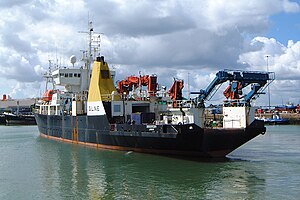RRS Discovery (1962): Difference between revisions
Rescuing 1 sources and tagging 0 as dead. #IABot (v2.0beta14) |
m convert HTML entities, punctuation (via WP:JWB) |
||
| Line 52: | Line 52: | ||
|Ship endurance= 55 days |
|Ship endurance= 55 days |
||
|Ship power= 3716 kW |
|Ship power= 3716 kW |
||
|Ship propulsion= Diesel electric system with 2 × Mirrlees Blackstone ESL6 and 2 × Mirrlees Blackstone ELS9 Mk2 diesels driving a propulsion motor. 360 |
|Ship propulsion= Diesel electric system with 2 × Mirrlees Blackstone ESL6 and 2 × Mirrlees Blackstone ELS9 Mk2 diesels driving a propulsion motor. 360° Azimuthing Bow Thruster unit |
||
|Ship speed= 11.0 knots (max: 12.5 knots) |
|Ship speed= 11.0 knots (max: 12.5 knots) |
||
|Ship capacity= |
|Ship capacity= |
||
Revision as of 15:47, 4 June 2019
 RRS Discovery
| |
| History | |
|---|---|
| Name | RRS Discovery |
| Owner | NERC National Marine Facilities Division |
| Builder | Hall Russell, Aberdeen[2] |
| Yard number | 899[2] |
| Laid down | 1962 |
| Launched | 3 July 1962 by Mary Viscountess Hailsham |
| Out of service | 14 December 2012 |
| Identification |
|
| Status | Inactive; to be dismantled |
| General characteristics | |
| Class and type |
|
| Tonnage | 3008 tonnes (gross)[2] |
| Displacement | 4378 tonnes |
| Length | 90.0 m[1] |
| Beam | 14.0 m[1] |
| Draught | 5.52 m (full load) |
| Depth | 7.83 m[2] |
| Installed power | 3716 kW |
| Propulsion | Diesel electric system with 2 × Mirrlees Blackstone ESL6 and 2 × Mirrlees Blackstone ELS9 Mk2 diesels driving a propulsion motor. 360° Azimuthing Bow Thruster unit |
| Speed | 11.0 knots (max: 12.5 knots) |
| Endurance | 55 days |
| Crew | 9 Officers; 13 Crew; 28 Scientists |
RRS Discovery was a British Royal Research Ship operated by NERC.
RRS Discovery (III) was built in Aberdeen in 1962 and named after Robert Falcon Scott's 1901 ship, RRS Discovery. Until 2006, she was the largest general purpose oceanographic research vessel in use in the United Kingdom. Measuring 90 metres in length, and fitted with a broad range of oceanographic equipment, Discovery could also accommodate containerized laboratories. She had berths for 28 scientific staff, and the ability to spend up to 45 days at sea.[3] Her last major overhaul was in 1991,[4] when a new superstructure and power plant were installed and her hull lengthened by 10 metres.[5]
Discovery carried out oceanographic and marine biology research from the National Oceanography Centre, Southampton. She operated as part of a fleet maintained by the Natural Environment Research Council (NERC) National Marine Facilities Division (NMFD), along with the larger RRS James Cook.
In February 2000, Discovery observed some of the largest waves, up to 29.1 metres, recorded by scientific instruments up to that time.[6]
Discovery (III) has been replaced by another ship,[7] and after extensive enquiry within the scientific community, the replacement vessel was named "Discovery" (IV).[8] The 1962 vessel retained the name until disposal. The new vessel has been designed by Skipsteknisk AS of Norway and built in Spain by C.N.P. Freire, S.A for delivery in 2013 and to be available for scientific research in 2014.[9]
Gallery
-
RRS Discovery leaving the Mersey.
-
RRS Discovery inbound to Southampton.
-
RRS Discovery inbound to Southampton April 2011.
Footnotes
- ^ a b c d e "RRS Discovery (IMO: 5090660)". Vessel Tracker. Retrieved 7 June 2009.
- ^ a b c d "Discovery". Vessel Assessment System. Retrieved 7 June 2009.[permanent dead link]
- ^ "RRS Discovery". Natural Environment Research Council. Archived from the original on 28 May 2009. Retrieved 5 June 2009.
{{cite web}}: Unknown parameter|dead-url=ignored (|url-status=suggested) (help) - ^ "RRS Discovery". Inter-Agency Committee on Marine Science and Technology. Archived from the original on 6 December 2007. Retrieved 4 January 2008.
{{cite web}}: Unknown parameter|deadurl=ignored (|url-status=suggested) (help) - ^ "National Marine Facilities - Sea Systems: RSS Discovery". National Oceanography Centre - University of Southampton. Archived from the original on 16 July 2012. Retrieved 13 June 2013.
{{cite web}}: Unknown parameter|dead-url=ignored (|url-status=suggested) (help) - ^ Holliday, NP, MJ Yelland, RW Pascal, VR Swail, PK Taylor, CR Griffiths, and EC Kent (2006). Were extreme waves in the Rockall Trough the largest ever recorded? Geophysical Research Letters, Vol. 33, L05613
- ^ "Tenth Report". House of Commons Select Committee on Science and Technology. Retrieved 5 June 2009.
- ^ confirmed by Alan Thorpe, NERC Chief Executive
- ^ "RRS Discovery". National Oceanography Centre (NERC). Archived from the original on 26 April 2014. Retrieved 7 September 2013.
{{cite web}}: Unknown parameter|dead-url=ignored (|url-status=suggested) (help)



